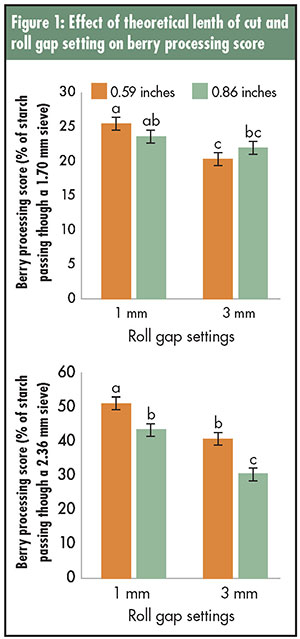
Availability of high-quality forages to dairy cattle is essential to maintaining rumen health and animal production. Although corn silage is the predominant forage used to feed dairy cows in the United States, sorghum has become an important silage crop for dairy farmers. This is primarily related to water availability being a limiting factor to forage production in many regions.
Sorghum is more water efficient, drought tolerant, and has reduced production costs when compared to corn. Therefore, whole-plant sorghum silage has been discussed as a potential replacement for whole-plant corn silage. Previously, we discussed the drawbacks of sorghum silage, which include higher concentrations of lignin, acid detergent fiber (ADF), and neutral detergent fiber (NDF), and lower NDF digestibility and starch concentration. Issues associated with NDF digestibility could be mitigated by using more digestible, brown midrib hybrids. However, the careful replacement of corn silage with sorghum silage is still recommended due to the reduced starch concentrations and digestibility of sorghum plants.
Similar to the corn kernel, pericarp and a starch-protein matrix act as barriers to starch digestion in sorghum berries. Although aggressive mechanical processing is well-established as an important tool in mitigating these barriers to digestion and enhancing starch digestibility of corn silage, research is still warranted for sorghum silage.
Evaluation needed
Knowing how to evaluate if processing was effective is crucial to assess machine function. For example, the corn silage processing score method, which uses a 4.75 millimeter (mm) sieve to quantify the adequacy of kernel processing in corn silage (percent of total starch passing through a 4.75 mm sieve), has been widely adopted and successfully led the dairy industry to improve the degree of kernel breakage in corn silage. More aggressive kernel processing improves total tract starch digestibility and lactation performance when compared to less aggressive processing in corn silage.
Until recently, a standardized measurement to determine adequacy of berry processing in sorghum silage had not been established. In 2017, researchers from Kansas State University proposed using a 1.70 mm sieve as the critical sieve to produce a berry processing score (percent of total starch passing through a 1.70 mm sieve). Samples with at least 50 percent of total starch passing through a 1.70 mm sieve would be scored as “adequate.” Conversely, samples with less than 50 percent of total starch below the 1.70 mm sieve would receive an “inadequate” berry processing score (BPS).
Implementation of a standardized BPS could allow for the quantification of the adequacy of processing and maximization of starch utilization in sorghum silage. Thus, this attempt by these researchers to create a BPS will certainly bring great benefits to the silage industry.
BPS evaluated
We conducted two experiments to learn more about BPS in sorghum silage. For the first experiment, berries from 25 hybrids were collected at various silage maturities and combined into three equal composites. Berries from one composite were kept intact, whereas the other two composites were manually cut into two or four pieces. Particle size distribution and starch digestibility are in Table 1.

As designed, our results indicated that manual cutting of berries reduced particle size, expanded the surface area for digestion, and consequently improved starch digestibility. However, it was intriguing to learn about the inability of many berries to pass through the 1.70 mm sieve even when manually cut in two or four pieces.
Only 3 and 26 percent of two and four pieces, respectively, passed through the 1.70 mm sieve. In contrast, 51 and 86 percent of berries cut at two and four pieces, respectively, passed through the 2.36 mm sieve. Based on our individual dataset, the use of the 2.36 mm sieve could represent a better indication of broken berries.
We designed our second study to evaluate the berry processing score with whole-plant sorghum silage. Briefly, we collected sorghum plants from four plots and processed them with a forage harvester to achieve combinations of two roll gap (1 or 3 mm [0.04 or 0.12 inches]) and two theoretical lengths of cut (15 or 22 mm [0.59 or 0.86 inches]) settings. Processing settings used in our study are representative of industry standards in the production of corn silage. It is reasonable to assume that similar processing settings would be used during the harvest of sorghum silage.
New sieve size proposed

Our results from the first study indicate that modern forage harvesting equipment may need to process sorghum berries to greater than four pieces to allow at least 50 percent of total starch to pass through the 1.70 mm sieve. Therefore, changing the critical sieve size from 1.70 to 2.36 mm is likely warranted.
When berry processing score was estimated using the 2.36 mm sieve, a wider range of scores were observed (Figure 1). In addition, the most aggressive treatment was considered adequate. Upon visual inspection (Figure 2), berries retained below the 2.36 mm sieve were processed in at least two pieces such as observed in the particle distribution of our first study.

Our study underscored the difficulty of processing sorghum silage, indicated by “inadequate” berry processing scores even when aggressive processing was applied. In addition, the 2.36 mm sieve may be the correct critical sieve to produce berry processing scores. The ability to accurately measure berry processing scores may improve nutritive value by increasing berry breakage and starch digestibility of sorghum silage.
This article appeared in the January 2020 issue of Hay & Forage Grower on page 30.
Not a subscriber? Click to get the print magazine.

